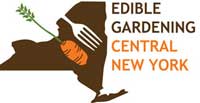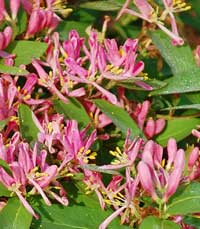|
Cornell Plantations' Third Natural Areas Academy starts March 3
|
 | | Clark Reservation |
|
Do you love spending time in the forests, meadows and other natural areas of the Finger Lakes region? Do you care about preserving the integrity of the natural world and do you want to share this love with others? If so, consider joining Plantations' Natural Areas Academy.
The year-long Natural Areas Academy (NAA) consists of dozens of expert-led workshops, field trips, and directed stewardship opportunities designed to provide participants with the knowledge, tools, and skills needed to support efforts in preserving our treasured natural resources.
Using Plantations' Natural Areas as outdoor classrooms, the NAA aims to foster the conservation of natural areas and rare species and their habitats by demonstrating essential stewardship methods, cultivating environmental literacy, and encouraging interactive experience with the natural world.
After participating in this one-year program, participants become certified and are conferred the title of Natural Areas Mentor. They may continue to participate in the academy as a NAA Mentor at no cost.
An HGCNYer who has participated previously highly recommends the program.
For more information,
Deadline is March 2.
|
|
Annual Soil & Water Conservation District Plant Sale
|
 | |
Red oak in late fall
|
|
This can be an opportunity to get inexpensive plants, many of which are native, BUT not all (for example, rose of sharon, which we would not recommend).
Do some research before ordering-- but you should always do this before selecting plants!
Here are some of the natives offered:
Balsam fir, hemlock, red pine, white pine, American cranberry viburnum, American filbert, black cherry, paper birch, red maple, red oak, white oak, strawberry bush, sugar maple.
There are also conservation packs of ferns and a songbird mix of trees/shrubs.
(We do not recommend the "butterfly conservation pack.")
Orders are due by March 16.
Plant descriptionsOrder Form |
| Our Habitat Garden |  |
Visit Our Habitat Garden website for information on providing habitat, earth-friendly gardening practices, plants, and various creatures here in Central New York. |
| HGCNY on Facebook |
As as more of us participate on our Facebook page, this will become a useful resource for asking (and answering!) local HGCNYers' questions about habitat gardening. Join in what can become a very useful conversation about habitat gardening in Central New York.
|
|
Join HGCNY!
|  |
Becoming an official member of HGCNY is easy: just join Wild Ones! When you're a Wild Ones member, you're automatically an official member of HGCNY. |
| Interested in Edible Gardening? | 
|
If you'd like to get information on Edible Gardening CNY, just email John to find out about edible gardening tours and programs.
|
|
Greetings!
 | | Non-native invasive honeysuckle |
You most likely know that Carol Bradford writes a popular column in the Post-Standard answering readers' questions about plants. But do you know that she also is a member of a New York State task force studying the impacts of non-native invasive plants? At our February 26 meeting, you can hear what she has to say about this important issue.
A what a fitting way to observe National Invasive Species Awareness Week February 26 - March 3!
WHEN: Sunday, February 26 at 2:00 PM
WHERE: Liverpool Public Library (Directions)
Free and open to the public.
Come and bring a friend!
 Cancellations? Cancellations?
In HGCNY's ten-year history, we've cancelled very few programs, but here in CNY, storms are always a possibility.
If the weather is bad, call Liverpool Library at 457-0310 to see if it's closed. Also, look for an email or check Facebook or our website for cancellation information.
 Sunday March 4 Sunday March 4
I'll be speaking about Gardening for Monarchs and Other Butterflies at the 2012 CNY in Bloom show on Sunday, March 4 at 2:00 pm. This year, it's being held at the SRC Event Center at OCC.
~ Janet Allen
|
|
 | |
Chickadee checking out a nest box
|
Getting nest boxes ready for spring
Spring will soon be here and birds will start looking for places to raise their young. Some species nest in trees, shrubs, or on the ground, but some nest in tree cavities or in nest boxes.
Advice from the Cornell Lab of Ornithology about attracting birds with nest boxes:
* Decide the species you'd like to attract and learn more about them in their Bird Guide. Is that species found around here? Does your yard have the specific kind of habitat they need?
* Find the proper location, orientation, and height for the nest box for the species you're trying to attract. * Don't put up a nest box unless you have the time to manage it, keeping it clean and in good repair. * If you're providing a nest box for bluebirds or Purple Martins, which are especially vulnerable to aggressive House Sparrows and European Starlings, learn to identify these invasive competitors and manage your nest box to exclude them. Read more from Cornell about Nest Box Basics. |
|
Dishwater Detergent and Nutrient Runoff Law of 2010 now in effect
 | |
Pesticide-free is safe for kids
|
Okay, so why are we HGCNYers interested in a law about dishwater detergent? Besides the fact that phosphorus from any source affects our water resources, the "Nutrient Runoff" part also refers to lawn fertilizers.
Here is a summary of the requirements of the law from the Buffalo Niagara Riverkeeper website: * Use of phosphorus fertilizer on lawns or non-agricultural turf is restricted to when a new lawn is being established or when a soil test indicates additional phosphorus is needed. * Application of any fertilizer on lawns or non-agricultural turf is prohibited between December 1 and April 1. * Application of any fertilizer on lawns or non-agricultural turf within 20 feet of a water body or on paved surfaces is restricted. * Retailers must display phosphorus fertilizer separately from phosphorus-free fertilizer and must post signs notifying customers of the terms of the law. More information on the law is on the DEC website. Better yet... Of course, even better is to dramatically reduce the size of our lawns altogether and take care of the remaining lawn organically. Here's more information on lawns from Our Habitat Garden. |
|
Check out these SUNY-ESF presentations on native plants
 | Native columbine
(Aquilegia canadensis) |
You can view two recent SUNY-ESF presentations on native plants and landscaping online. (They're both on the upper right corner of the webpage.)
The first presentation is Native Plants for Sustainable (and more interesting) Landscapes by Don Leopold. The second presentation is Native Plants for Sustainable Landscapes by Timothy Toland.
They're both large .pdf files, but well worth taking the time to download and view them. |
 | |
Mayapple
|
Time for Project BudBurst
As pleasant as the warm winter may have been, it's also a reminder of how our climate is changing, bringing with it a host of less pleasant consequences. (Here are Northeast-specific factsheets on some of the impacts.)
You can help collect information about how the climate is changing by observing how spring arrives in our own landscapes.
Project BudBurst is a network of people across the country who have been monitoring plants as the seasons change since 2007.
This year, they're especially interested in collecting data on their 10 Most Wanted Plants. Why are these plants wanted? Because over the last few years, people have submitted the most information on these plants, so scientists will best be able to compare new information against this larger set of past data.
Here are the 10 Most Wanted Plants
Common lilac (Syringa vulgaris)
Garden forsythia (Forsythia xintermedia)
Chokecherry (Prunus virginiana)
Balsam poplar (Populus balsamifera)
Red maple (Acer rubrum)
Red osier dogwood (Cornus sericea)
Red columbine (Aquilegia canadensis)
Spiderwort (Tradescantia ohiensis)
Virginia bluebells (Mertensia virginica)
Mayapple (Podophyllum peltatum)
Please consider participating this year by observing your chosen plant, either one (or more) of these Most Wanted plants or other plants of interest to Project BudBurst. Here's how to participate in this important project. |
 | |
Sharp-shinned hawk in the backyard
|
Save an apple core, save a life
Those of us who compost know that it doesn't take long for things like apple cores to decompose. Even though we'd never think of littering by throwing food wrappers or other things out the car window, we might be tempted to throw out things that quickly decompose. BUT don't do it! Why? As the Backyard Ecosystem blog points out, throwing food out along the roadside attracts rodents, and the rodents attract predatory birds.
Sixty percent of injured birds brought in for care at the Carolina Raptor Center are from car strikes. So just as you save your paper litter for your garbage can at home, save your biodegradables for your home compost pile, and save a life! |
|
|
|
|